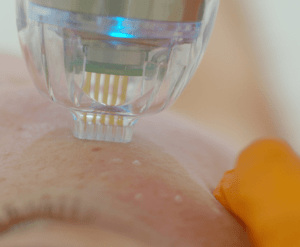 Microneedling has gained significant popularity in recent years as a non-invasive skincare treatment that promises remarkable results. In this comprehensive guide, we will delve into what microneedling is, how it works, its benefits, and what to expect from this innovative facial procedure.
Microneedling has gained significant popularity in recent years as a non-invasive skincare treatment that promises remarkable results. In this comprehensive guide, we will delve into what microneedling is, how it works, its benefits, and what to expect from this innovative facial procedure.
What is Microneedling?
Microneedling, also known as collagen induction therapy, is a minimally invasive cosmetic procedure that involves using a device with fine needles to create tiny punctures in the skin’s surface. These micro-injuries stimulate the body’s natural healing process, leading to increased collagen and elastin production, which are essential for maintaining skin elasticity and firmness.
How Does Microneedling Work?
During a microneedling session, a trained skincare professional will use a specialized device equipped with tiny needles to create controlled micro-injuries on the skin’s surface. These needles penetrate the epidermis, reaching the dermis where collagen and elastin fibers are located. The body responds to these micro-injuries by initiating the healing process, which includes producing new collagen and elastin.
Benefits of Microneedling
- Improved Skin Texture: Microneedling can help improve the overall texture of the skin by reducing the appearance of fine lines, wrinkles, and acne scars. The increased collagen production leads to smoother and more youthful-looking skin.
- Reduction of Hyperpigmentation: For those dealing with hyperpigmentation issues such as sunspots or melasma, microneedling can help lighten these dark spots and create a more even skin tone.
- Enhanced Absorption of Skincare Products: The micro-channels created during microneedling facilitate better absorption of topical skincare products, allowing for more effective delivery of active ingredients deep into the skin.
- Minimization of Pore Size: Regular microneedling treatments can help reduce the size of enlarged pores, giving the skin a smoother and more refined appearance.
- Stimulation of Hair Growth: In addition to its benefits for facial skin, microneedling can also stimulate hair follicles, promoting hair growth and improving the thickness and quality of hair.
- Reduction of Stretch Marks: Microneedling has shown promising results in reducing the appearance of stretch marks, particularly when combined with other skincare treatments.
What to Expect During a Microneedling Session
Before undergoing microneedling, it’s essential to consult with a qualified skincare professional to determine if you are a suitable candidate for the procedure. During the session:
- The skin will be cleansed and prepped.
- A numbing cream may be applied to minimize discomfort.
- The microneedling device will be passed over the skin in targeted areas.
- A soothing serum or mask may be applied post-treatment to enhance results and promote healing.
Post-Treatment Care
After microneedling, it’s crucial to follow your skincare professional’s instructions for post-treatment care, which may include:
- Avoiding direct sun exposure and wearing sunscreen daily.
- Using gentle skincare products and avoiding harsh chemicals or exfoliants.
- Keeping the skin hydrated with moisturizers.
- Avoiding strenuous exercise or activities that may cause excessive sweating immediately after treatment.
Microneedling is a versatile and effective skincare treatment that offers a range of benefits, from improving skin texture and reducing hyperpigmentation to stimulating hair growth and minimizing stretch marks. With proper consultation and post-treatment care, microneedling can help you achieve smoother, healthier, and more radiant skin.
Common Questions About Microneedling
Microneedling may cause some discomfort, but it is generally tolerable for most people. The procedure involves using a device with fine needles to create controlled micro-injuries on the skin’s surface, which can result in a tingling or stinging sensation. However, numbing creams or local anesthesia can be applied before the treatment to minimize discomfort. Additionally, the depth and intensity of microneedling can be adjusted based on individual pain tolerance and skin sensitivity.
The timeframe for visible results from microneedling can vary depending on factors such as the individual’s skin condition, the depth of microneedling, and the number of sessions. Some people may notice improvements in skin texture and appearance within a few days to a week after the treatment, while more significant changes, such as reduced fine lines, acne scars, and improved collagen production, may become noticeable after several weeks to months of consistent treatments. It’s essential to follow the recommended treatment plan and maintain good skincare practices for optimal results.
Microneedling is generally safe for most skin types, including sensitive skin, when performed by a trained and experienced skincare professional. However, certain skin conditions or medical history may require precautions or adjustments in the microneedling procedure. It’s crucial to consult a qualified provider to assess your skin’s suitability for microneedling and address any concerns or contraindications. Additionally, post-treatment care and sun protection are essential to ensure proper healing and minimize the risk of adverse reactions.